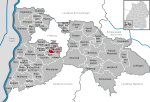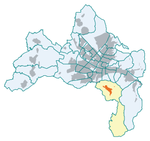The village Günterstal is the southernmost district of Freiburg im Breisgau. It is located in the so-called Bohrer-Tal area (where the craft of "Deichel-Bohrer", preindustrial wooden water pipes used for the distribution of water, took place) at the foot of the 1284 metre-high Schauinsland in the Günterstal district of the Black Forest. Due to this, Freiburg prides itself on being Germany's highest city. Günterstal has more than 2,000 inhabitants and is separated from Freiburg by a two-kilometre-wide meadow, the "Wonnhaldewiesen". The village was incorporated into Freiburg in 1890. The southern neighbouring municipality is Horben.
Günterstal is mentioned by name for the first time in a property deed from the year 804, at that time as "Gundherrerhusir" (Houses of Günther) in the march of Merzhausen. Around 300 years later the town reappeared under the name "Guntheristal". Around 1221, a nobleman, who according to tradition from the 18th century was called Günther of Kibenfels, gave his daughter Adelheid land in Günterstal. There she built a small monastery (monastic attachment?). In a document from 1224, the nunnery was first mentioned in "Gunterstal". However, Günther von Kibenfels cannot be the town's namesake because "Günter" appeared in the place name much earlier.
The community around Adelheid joined the Cistercian order, which, especially since Bernhard of Clairvaux had also preached in Freiburg, sparked enthusiasm during the Crusade movement. After the death of Adelheid's father, his other possessions were also passed on to the monastic community, including the "Kibenfels" castle (on the Kybfelsen mountain). A property register from 1344 shows that the nunnery owned properties in 90 villages at the time, including today's city animal enclosure in Mundenhof. At this time, the municipality of Günterstaal comprised around 25 houses in addition to other properties. Noble families of the region such as the Küchlin, the Geben, and the Schnewlin made donations to the nunnery. Unlike in a so-called women's convent, their unmarried daughters entering the nunnery had to transfer all property to the nunnery and provide the abbesses, who also had a seat and voted in the Further Austrian Landstände (estates). In 1486 the nunnery was affected by a flood. The nunnery was also pillaged in periods of war and lost many possessions. In 1632 the nuns narrowly escaped the Swedes by fleeing to the Rheinau Abbey. In 1674 the nunnery, under Abbess Agnes von Greuth, released its subjects from servitude. After the economic situation of the nunnery had improved, in 1727 Abbess Maria Rosa von Neveu decided to replace the old nunnery building with a new building. In the period from 1728 to 1738, a completely new, baroque nunnery complex was built according to plans by Peter Thumb, under the abbess Maria Franziska Cajetana von Zurthannen, who came from the Black Forest and was as pious as she was energetic. Nothing of the abbey survived apart from the portal. Of the formerly rich furnishings of the abbey, only the following are still there: a Holy Blood relic that the Reichenau Abbey gave to the Cistercians in 1737, the associated monstrance from 1738 and the assumed baptismal font in Günterstal. Two side altars are now in the church of Buchenbach, the choir stalls in Kirchzarten, and the confessional in the church of the former Schuttern Abbey. The complex of nunnery buildings and their walls still characterise the town centre today. In 1806 the nunnery was dissolved by the order of Napoleon.










